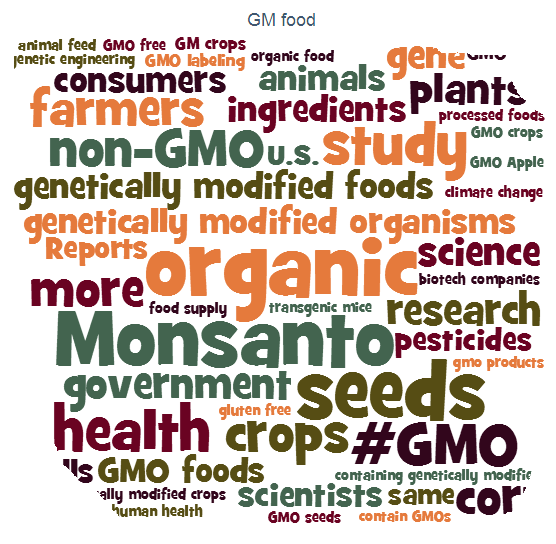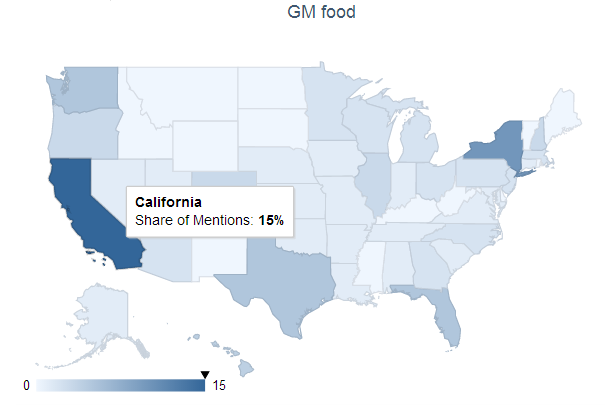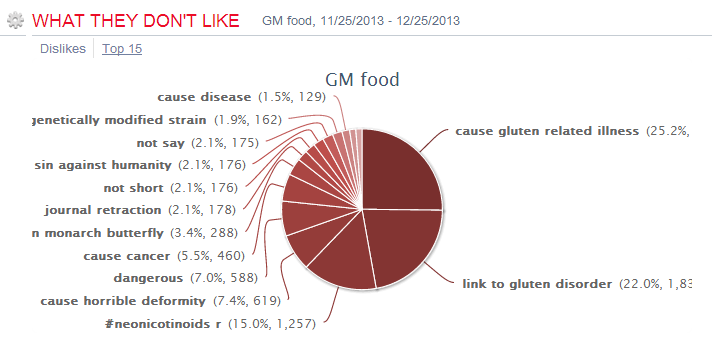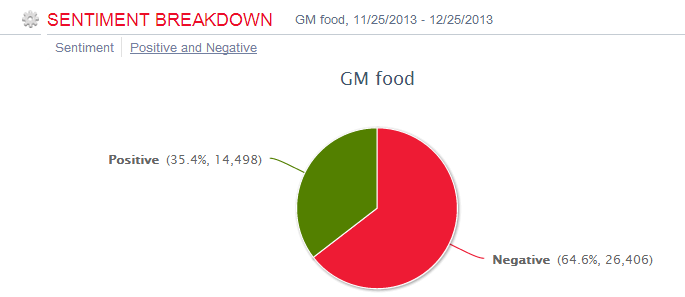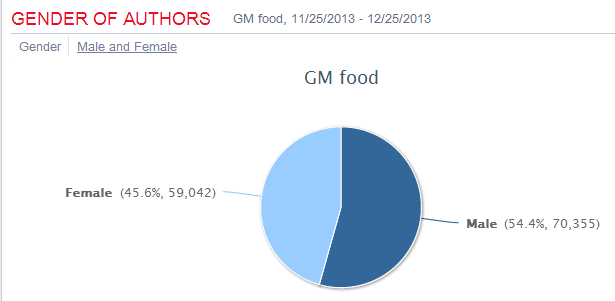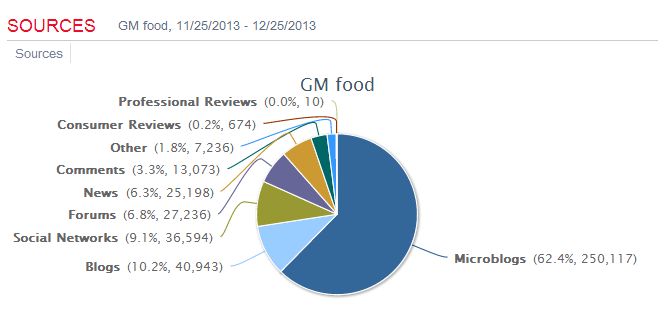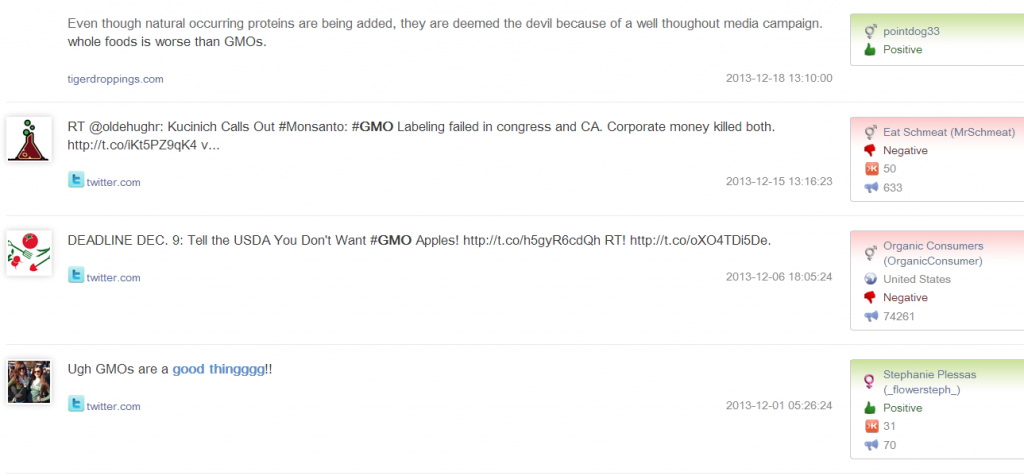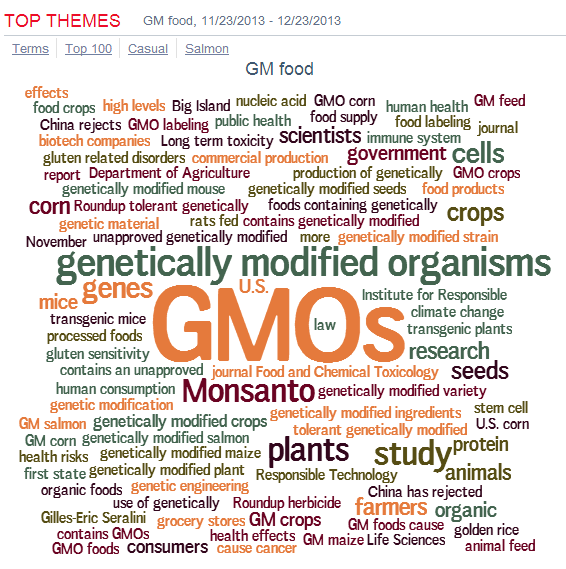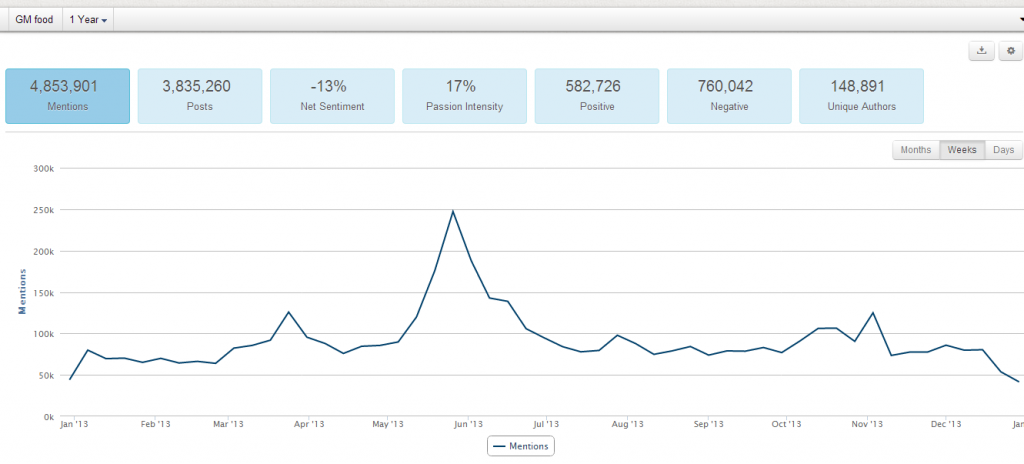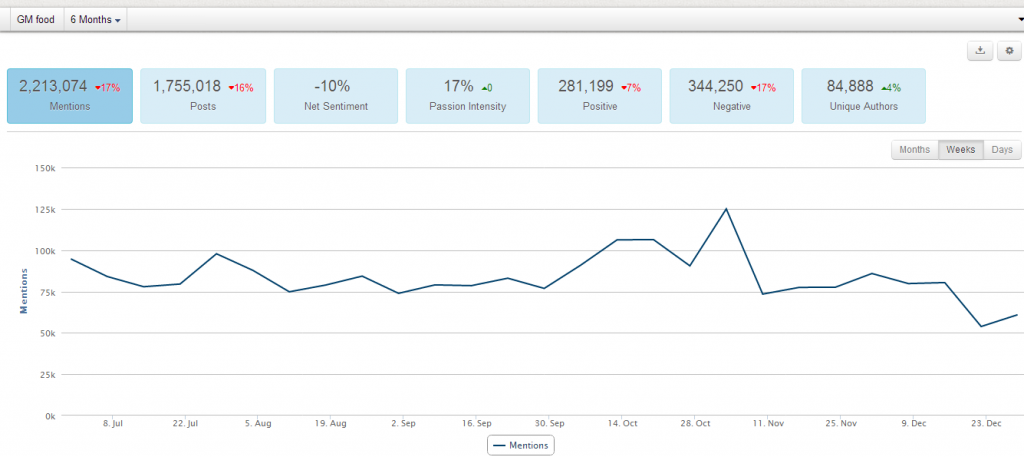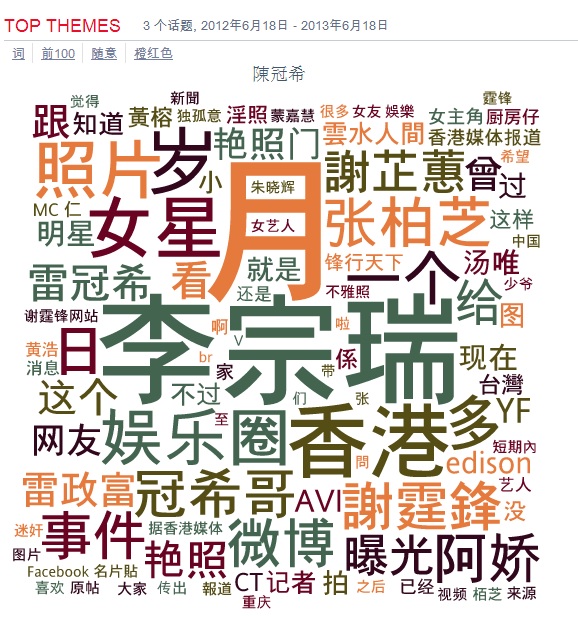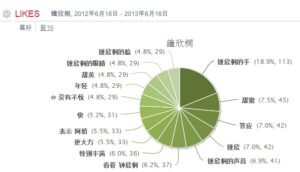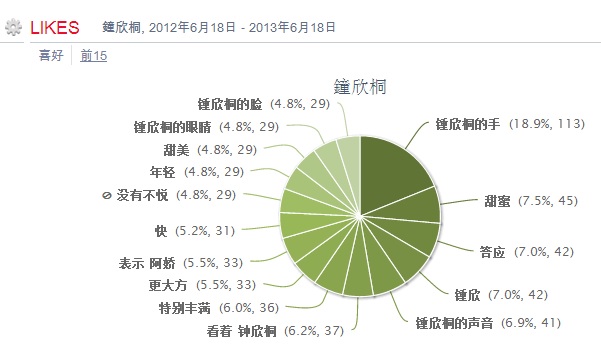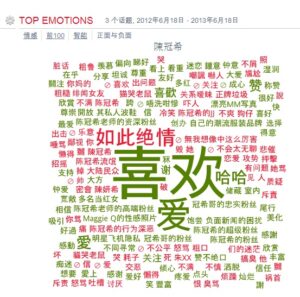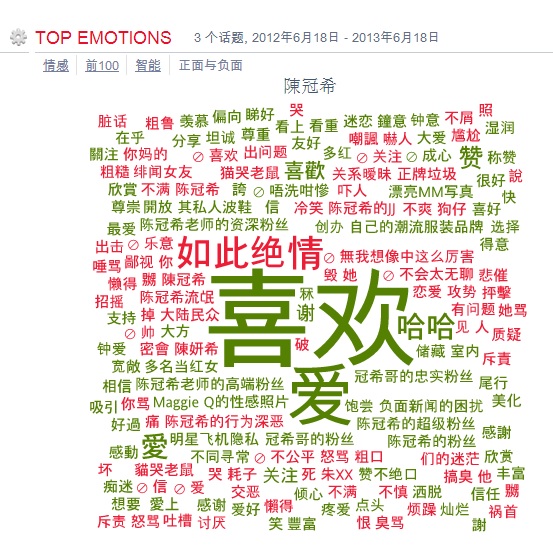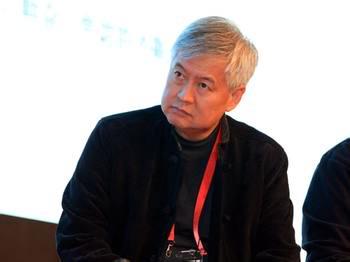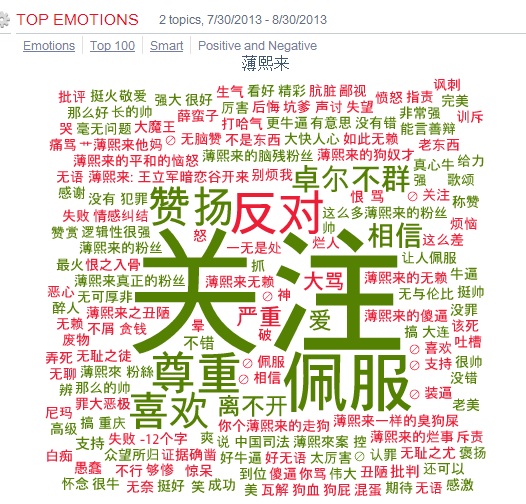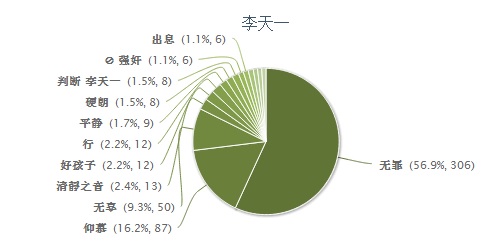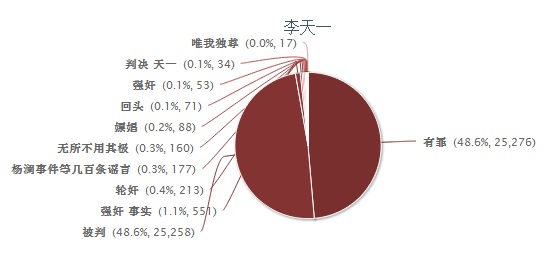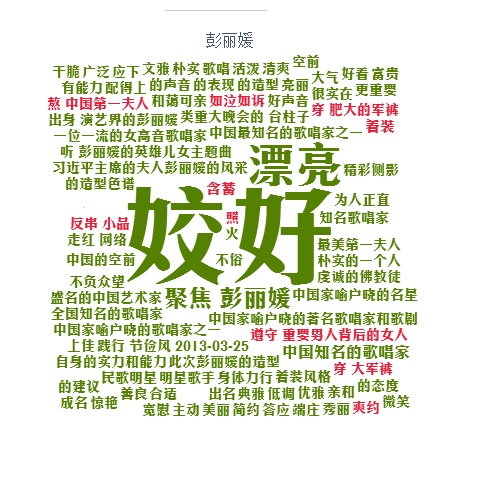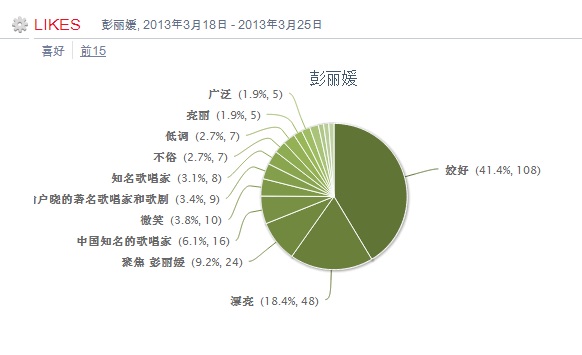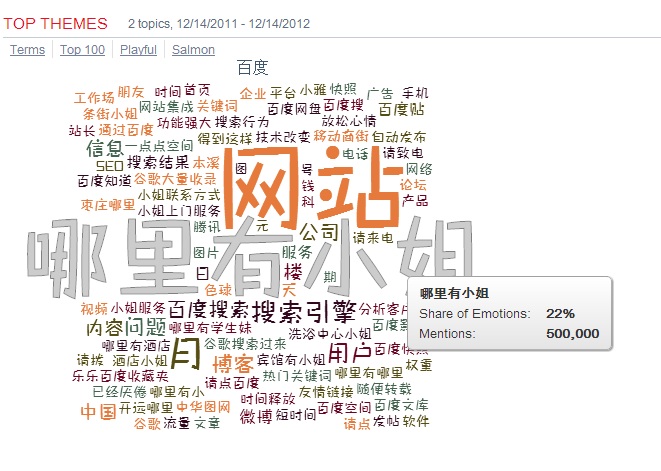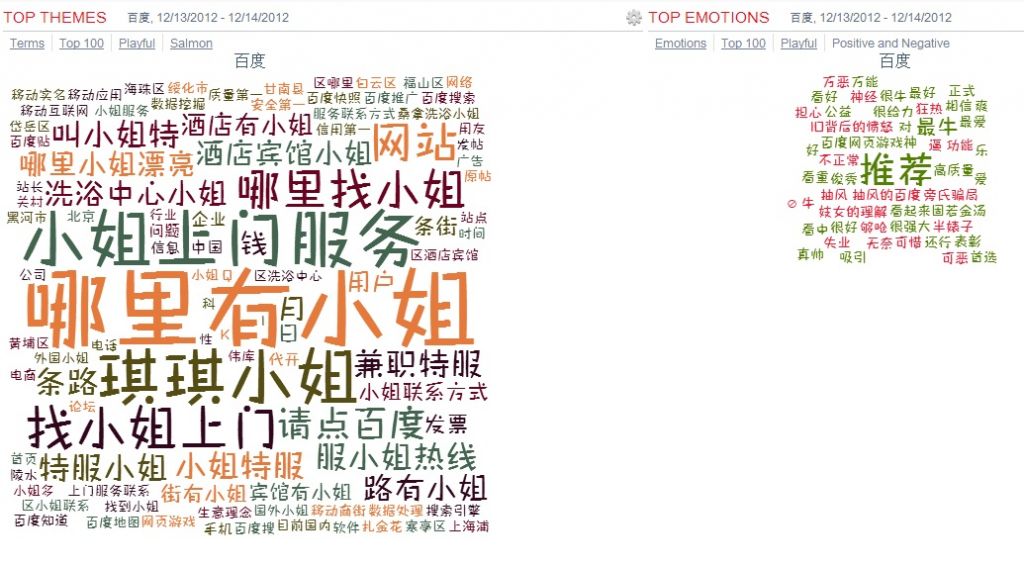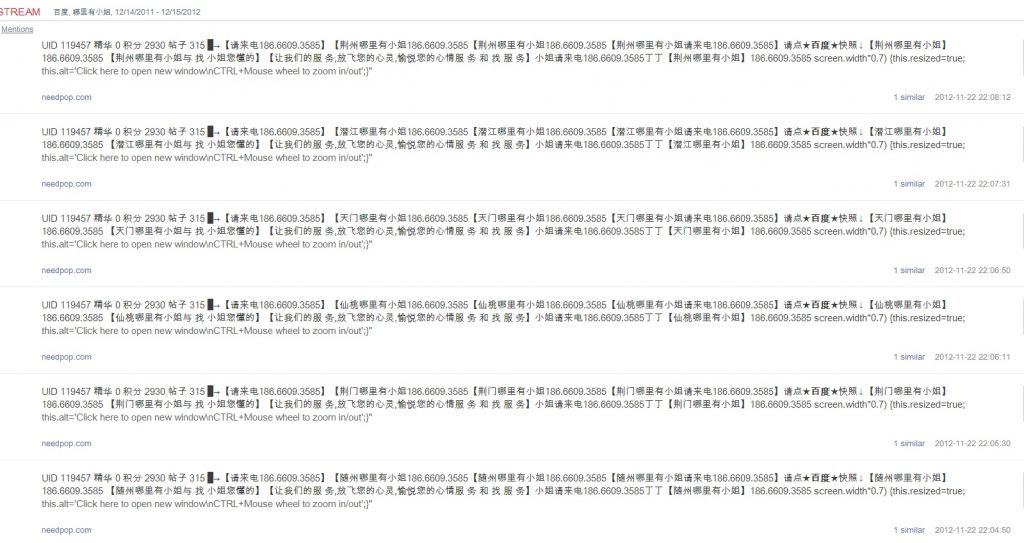【社煤挖掘:雷同学之死】
屏蔽 |||
这是最近的热点新闻,舆情鼎沸,有蔓延之势。值得挖掘和跟踪。



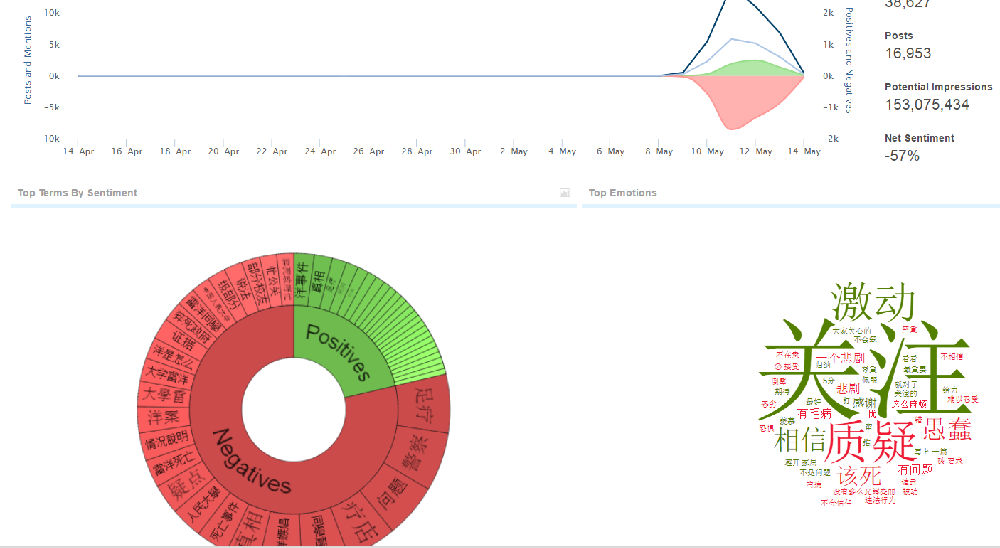

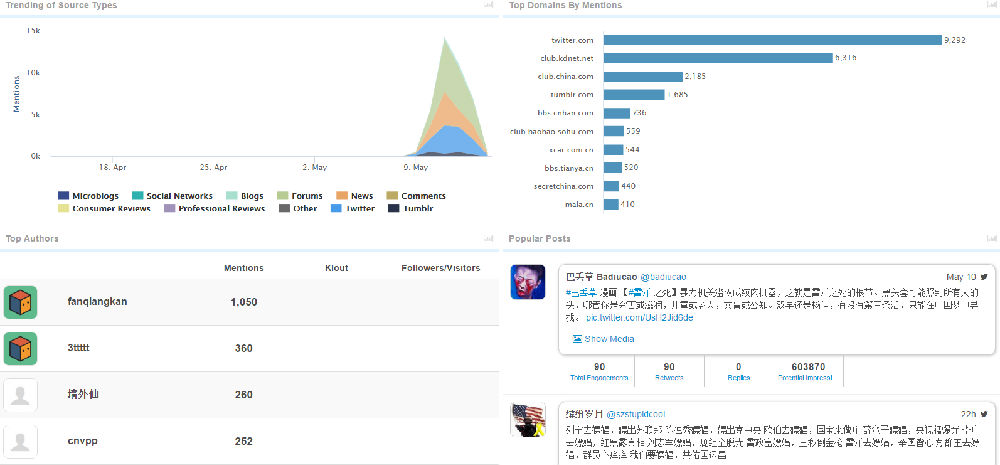
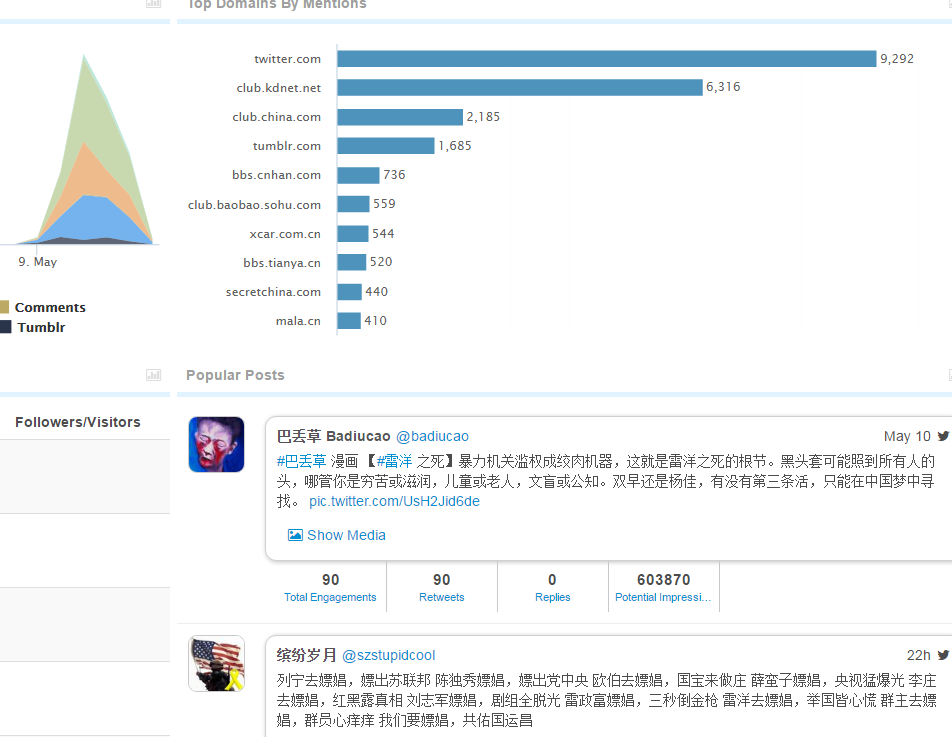








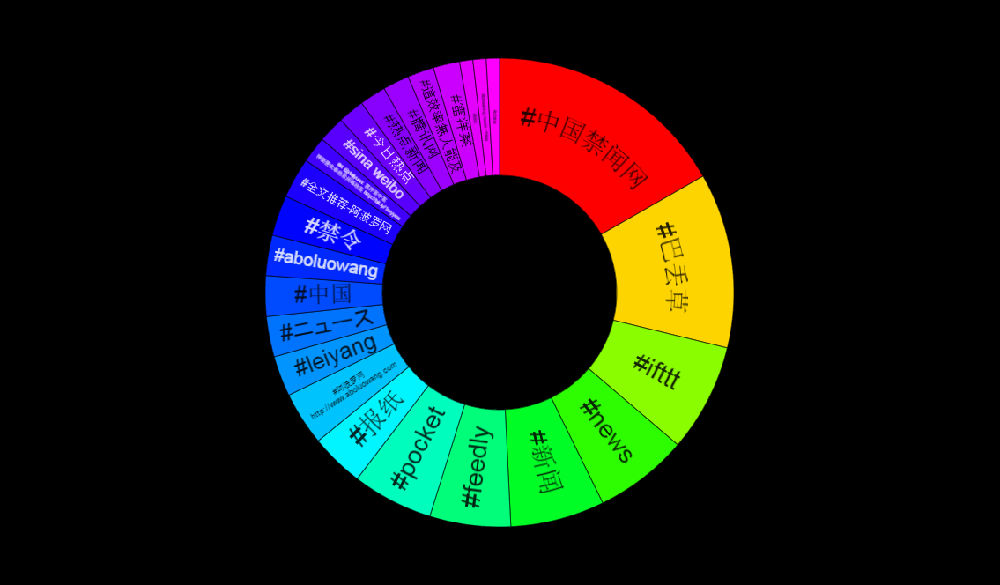

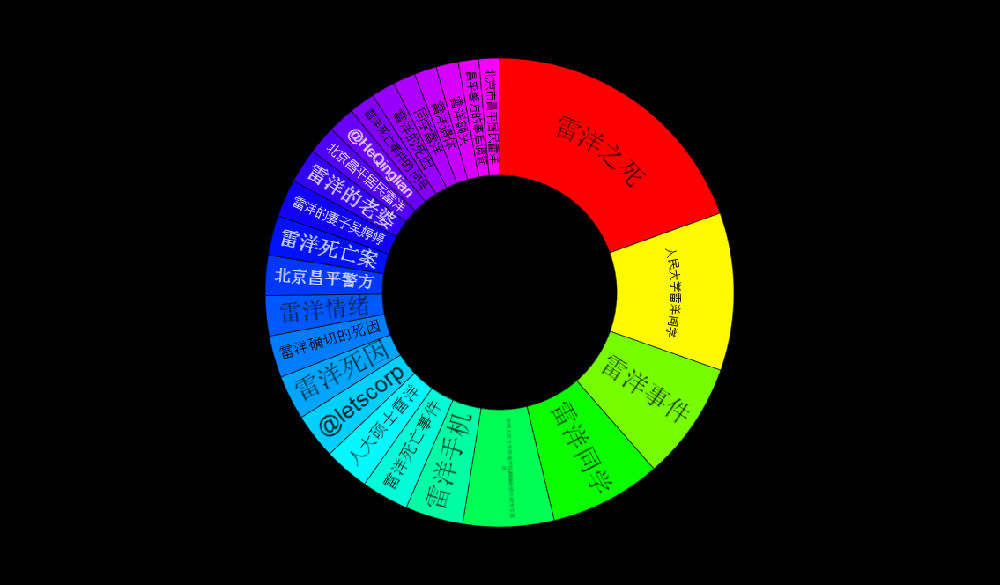
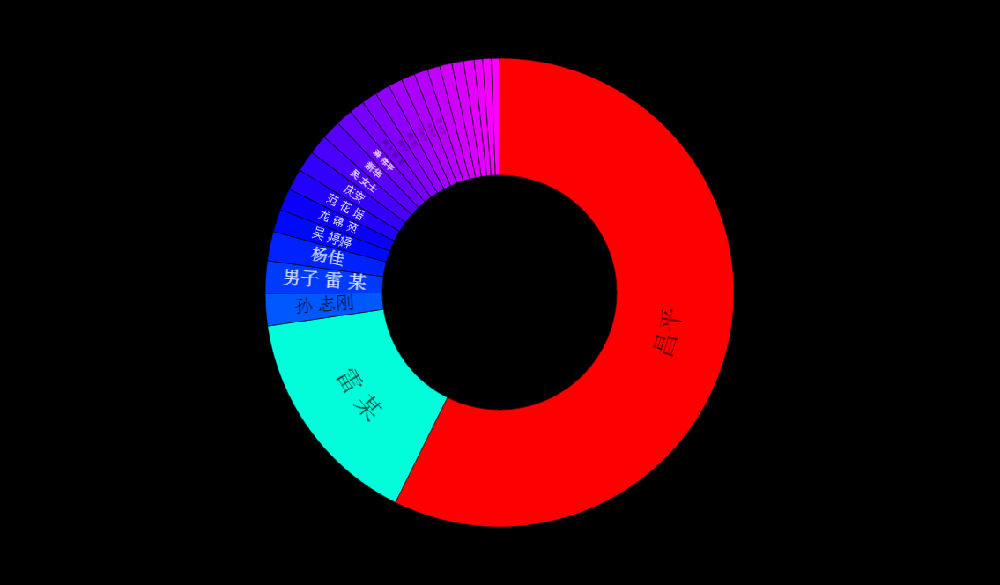
社煤选样:
|
雷洋遗体外伤严重 |
|
质疑雷洋案件十大疑点 |
|
雷洋妻报案:有充分证据警察涉故意伤害致死罪(图) |
|
雷洋事件解决不好,非正常死亡可能成为常态【时局深度】- |
|
蔡慎坤:血与泪的控诉还原雷洋遇害真相 |
|
对比家属报案书和警方通报再看雷洋致死案 |
|
转发雷洋案刑事报案书:描述死亡过程(真相即将到来)-衡阳 |
|
雷洋案件之疑点-第11页- |
|
血与泪的控诉还原雷洋遇害真相- |
|
网传'大学生屁股被警察叔叔打开花',警方:属实!图_中华论坛_中华网社区- |
|
雷洋死亡当晚到底发生了什么?央视专访当事警察 |
|
雷洋家属向北京市检报案要求侦查涉事民警- |
|
'他沒有嫖娼時間' 家屬報案指雷洋被無辜毆死 |
|
吴文萃(雷洋妻子):关于要求北京市检察院立案侦查雷洋被害案的刑事报案书 |
|
血与泪的控诉还原雷洋遇害真相 |
|
雷洋死有余辜! |
|
雷某的家人实在太不要脸了! |
|
“刑事报案书”描述雷洋之死【李鸣生】-常德 |
|
雷洋妻子报案,事件最新爆料!嫖娼是栽赃,雷洋被打死-休闲侃吧- |
|
[原创]雷洋遗孀之报案书等于官媒的死刑判决书 |
|
雷洋父母看完遗体后,为何当场给尸检证人下跪? |
|
雷洋最新情报:“刑事报案书”描述雷洋之死经历 |
|
关于要求北京市检察院立案侦查雷洋被害案的刑事报案书(转载) |
|
我们为什么要关注雷洋之死? |
|
雷洋案刑事报案书,警方涉嫌故意伤害(致人死亡)罪、滥用职权罪、帮助伪造证据罪- |
|
转帖:雷洋妻子向北京市检察院报案:嫖娼是栽赃,雷洋被打死 |
|
1) 雷洋家属告控告警方 2) 雷被殴打致死当日是雷结婚纪念日 3)尸检结果延迟到60天出结果 |
|
一个昌平“嫖娼者”为何引燃了全国公众的怒火?(转) |
|
陈有西律师曝雷洋案发现最新一个重要疑问 |
|
吴文萃(雷洋妻子):关于要求北京市检察院立案侦查雷洋被害案的刑事报案书 |
|
雷洋家属向北京市检报案,要求侦查涉事民警 |
|
【时评】雷洋之死,疑云重重 |
|
人大学生会秘书长郝鹏程说,雷洋嫖娼不是第一次。 |
|
作为正在人大读书的研究僧,分析雷案可能的结果吧- |
|
七律读微信圈雷洋数帖激愤有咏一气呵成重字不改也 |
|
何新:悼雷洋 |
|
哀悼环保烈士雷洋 |
|
血的事实告诉我,雷洋事件很快就平静下来! |
|
警察滥用国家暴力必须予以遏制 |
|
雷洋事件解决不好,非正常死亡可能成为常态【时局深度】- |
|
雷洋之死纯属咎由自取_中华论坛_中华网社区- |
|
人大硕士雷洋真的嫖娼了吗?十三省 |
|
朝吉:足疗送命记 |
|
雷洋之死击碎了中产阶级的优越感! |
|
昌平的一个“嫖娼者”为什么会引发公众的怒火 |
|
雷洋案:尽管真相还在路上,三种共识可以先到 |
|
北京公安回應雷洋案:決不護短 |
|
北京市检察院:已将雷某家属报案材料移送昌平检方 |
|
北京市公安局公开回应雷洋案:高度重视绝不护短 |
|
横河:雷洋案为什么应该怀疑警方 |
|
关于雷阳事件的随想 |
|
警察蜀黍为何喜欢抓嫖?- |
|
“雷洋事件”终于开了个好头 |
|
雷洋用牺牲捍卫一个公务员的尊严 _网上谈兵_中华网社区- |
|
从目击者证言和记者调查的报道看被忽略的雷洋事件关键点 |
|
雷洋被强押致死案,槽点多多,警方说辞漏洞百出 |
|
雷洋事件:中国人民大学88级部分校友向公安部门下战书 |
|
雷洋家属联系第三方鉴定机构将第二次与检方沟通- |
|
雷洋事件,显示了老百姓的焦虑,不安全和无助感_网罗天下_天涯论坛 |
|
雷洋的家属成了大输家!!! |
|
雷洋案真相不难搞清,但很多人打死也不愿相信 |
|
解密雷洋之死的根本原因!-常德 |
|
有见过抓嫖不在店里抓现行而在马路上盘查的吗 |
|
【视点】比雷某嫖娼事件真相更可怕的,是“相信”尽失! |
|
【时评】雷洋事件,送环球时报两字无耻 |
|
中国人民大学88级部分校友就雷洋同学意外身亡的声明 |
|
[原创]雷洋之死:给你真相又何妨? |
|
雷洋遗体外伤严重尸检后家属控告警方涉嫌犯罪 - 中国禁闻网 |
|
呼格案律师谈雷洋之死:涉事警察是嫌犯警方无权再接触证人-常德 |
|
民众为什么关注雷洋的案子? |
|
转载:雷洋妻子正式报案:嫖娼是栽赃,雷洋致命处睾丸异常肿大系被打死 |
|
妻子坚决捍卫老公嫖娼有理正义吗。打飞机不算嫖娼吗_中华论坛_中华网社区- |
|
雷洋之死的九大谜团,谁能告诉我们真相? |
|
雷洋案:守住私德的底线,恢复人性的的良知 |
|
一周新闻聚焦:雷洋之死掀起舆论风暴,各方谴责警方滥权 |
|
雷洋案:守住私德的底线,恢复人性的的良知 |
|
人大学生会秘书长郝鹏程说,雷洋嫖娼不是第一次。 |
|
雷洋案真相不难搞清,可怕的是有人就是打死也不愿相信 |
|
网友热议:雷洋的事,恐怖在哪儿?(图) - 看中国 secretchina.com |
|
雷洋尸检报告未出,但问题已显现:(第3页)_天涯杂谈_天涯论坛 |
|
[原创]嫖娼案拒谈嫖娼,雷洋老婆居心叵测,图谋不轨 |
|
雷洋死亡案铁证如山,雷洋没有白死 |
|
雷洋案新证据浮现:警察有问题 |
|
快讯!雷洋家属正式控告警方涉嫌犯罪 |
|
雷某嫖娼案最终结果的终极预测-第2页- |
|
雷洋怎么死的,我来分析下。 |
|
[原创]雷洋死因的逻辑分析 |
|
[原创]雷洋怎么死的?【猫眼看人】- |
|
雷洋嫖娼,谁又在嫖中国法律_天涯杂谈_天涯论坛 |
|
警方回应雷洋案热点问题昌平检方介入调查 |
|
【转帖】中国人民大学88级部分校友就雷洋同学意外身亡的声明- |
|
橫河:雷洋案為什麼應該懷疑警方 |
|
最新消息:从警方提供及其他方面提供的证据看,雷洋涉嫌“嫖娼”的疑问太多!【铁证】 - 有啥说啥 |
|
我们为什么要关注雷洋之死?(第4页)_关天茶舍_天涯论坛 |
|
雷阳嫖娼就可以打死吗?转_网罗天下_天涯论坛 |
|
我服了雷洋家人了,到底要闹哪样?没见过这么无赖的(第5页)_天涯杂谈_天涯论坛 |
|
[原创]草根今日谈:依法治国请从雷洋事件开始 |
|
人大部分88级校友就同学雷洋身亡声明:对恶我们不会忍太久全文 - 中国禁闻网 |
|
中国人民大学77、78级校友关于雷洋的声明 |
|
大陸雷洋離奇死亡聯合國貼文關注 |
|
雷洋尸检超过12个小时北京昌平警方回避不 |
|
热帖:为什么我们应该感谢雷洋的妻子(图) |
|
雷洋死有余辜! |
|
[原创]由雷洋事件看恶警李乐斌杀人未受惩罚的危害性 |
|
[原创]支持雷洋遗孀依法起诉诬陷其亡夫的媒体 |
|
雷洋之死的真相究竟是什么? |
|
[原创]雷洋,愿你的名字叫做公正与法治【猫眼看人】- |
|
雷洋事件,显示了老百姓的焦虑,不安全和无助感_网罗天下_天涯论坛 |
|
'嫖娼者'雷洋的安全感要不要保护 |
|
亦忱:简评陈有西代理雷洋案的前景 |
|
雷洋案新证据浮现:警察有问题 |
|
雷洋之死的两个最重要真相! - 云中茶社 |
|
[原创]由雷洋事件看恶警李乐斌杀人未受惩罚的危害性 |
|
雷洋家属发表声明:警方的做法是在混淆视听 |
|
昌平警方的行为完全合法! |
|
周小平:酷吏以法杀人,奸生以文灭口-真相为何败给愤怒?-第6页- |
|
雷洋案:守住私德的底线,恢复人性的的良知 |
|
[原创]三点详析雷洋事件严重亏空损耗了XX公信力! |
|
雷洋有没有嫖娼,有一个绝招,立刻就能见分晓! |
|
风云洞评劣等民族情商高?(图) |
|
周小平:酷吏以法杀人,奸生以文灭口-真相为何败给愤怒?-第6页- |
|
周小平:酷吏以法杀人,奸生以文灭口-真相为何败给愤怒?-第6页- |
|
雷洋有没有嫖娼,有一个绝招,立刻就能见分晓! |
|
雷洋案:守住私德的底线,恢复人性的的良知 |
|
涉案警方擅自检验死者DNA是否涉嫌违法犯罪? |
|
贾冀豫__北京出租车司机说雷洋是打死的 |
|
【风青杨专栏】对不起,我并不想知道雷洋如何嫖娼(第8页)_天涯杂谈_天涯论坛 |
|
雷洋之死让普通人感到无比恐惧 |
|
雷洋之死或可推动社会三大进步 |
|
雷洋之死让普通人感到无比恐惧 |
|
这不是两个人死亡的问题_社会热点_中华网社区- |
|
解密雷洋之死的根本原因!-常德 |
|
性价比。。。。_上海汽车论坛_XCAR |
|
有见过抓嫖不在店里抓现行而在马路上盘查的吗 |
|
雷洋嫖娼离奇死亡案。 |
|
重大消息!国资委官员嫖娼被抓猝死(组图) |
|
这不是两个人死亡的问题 |
|
张鸣:雷洋之死 |
|
雷洋案,网友如何“推波助澜”?全民一起破案,真相越来越近了吗?- |
|
人大硕士求救帖,几乎每一段都充斥着谎言! |
|
中国人民大学77、78级校友关于雷洋的声明 |
|
中国人民大学77、78级校友关于雷洋的声明 |
|
2016年05月13日 |
|
人大的校友别再发声了,77,78,84,88级的 |
|
女人天天被杀都激不起水花,雷洋死就激起千层浪! |
|
《雷洋案》引起北京公安局领导高度重视 |
|
雷洋是不是嫖娼不重要?扯淡!笔者用十点给某些人普法 |
|
快讯!雷洋家属正式控告警方涉嫌犯罪 |
|
雷洋案:守住私德的底线,恢复人性的的良知 |
|
雷洋事件也许将有助中国执法部门的公正、警醒? |
|
那些声嘶力竭认为雷洋嫖娼该死的人,他们是些啥人? |
|
雷洋事件也许将有助中国执法部门的公正、警醒? |
|
关注小人物的命运!就是关注自个命运!小人物之死网友理应关注 |
|
雷洋案:守住私德的底线,恢复人性的的良知 |
|
“欺负死人不能说话”乃世间首恶 |
|
“欺负死人不能说话”乃世间首恶 |
|
拿雷洋殒命事件大肆鼓噪的那些人,可把死者一家人害惨了 |
|
“欺负死人不能说话”乃世间首恶 |
|
[原创]“欺负死人不能说话”乃世间首恶 |
|
力瑾:還有多少國人在意雷洋案的真相? |
|
雷阳嫖娼就可以打死吗?转_网罗天下_天涯论坛 |
|
【野渡专栏】草根今日谈:依法治国请从雷洋事件开始_天涯杂谈_天涯论坛 |
|
【野渡专栏】草根今日谈:依法治国请从雷洋事件开始_天涯杂谈_天涯论坛 |
|
雷洋案:守住私德的底线,恢复人性的的良知 |
|
警方续昌平涉嫖男子在查处过程中突发死亡通报有无问题 - 第2页 - 警务探讨 |
|
[原创]草根今日谈:依法治国请从雷洋事件开始 |
|
【野渡专栏】草根今日谈:依法治国请从雷洋事件开始_天涯杂谈_天涯论坛 |
|
雷洋案:为何警方信息发布总显得很被动? |
|
【视点】比雷某嫖娼事件真相更可怕的,是“相信”尽失! |
|
【时评】雷洋事件,送环球时报两字无耻 |
|
中国人民大学88级部分校友就雷洋同学意外身亡的声明 |
|
'嫖娼者'雷洋的安全感要不要保护 |
|
打飞机为何没有改变雷洋案的舆情走向? |
|
一个昌平“嫖娼者”为何引燃了全国公众的怒火?(转) |
|
十族沦为下一个魏则西比雷洋尤恐怖 - 有图有真相 - 中豫爆料 |
|
十日谈;我想说几句了,关于何新的两篇文章_中华论坛_中华网社区- |
|
女人天天被杀都激不起水花,雷洋死就激起千层浪! |
|
女人天天被杀都激不起水花,雷洋死就激起千层浪! |
|
喝我这七星茶听他摆龙门阵再饮三盅 |
|
喝我这七星茶听他摆龙门阵再饮三盅 |
|
喝我这七星茶听他摆龙门阵再饮三盅 |
|
【今言野语】副省长私访被警察殴打的社会问题?_新闻众评_天涯论坛 |
|
[原创]雷洋死亡案铁证如山,雷洋没有白死 |
|
雷洋死亡案铁证如山,雷洋没有白死 |
|
说雷阳打飞机我的看法不成立!_中华论坛_中华网社区- |
|
陈中华;警察威严不容丧尽,法律遵严不容侵犯_中华论坛_中华网社区- |
|
为违法警察洗地,无耻!_中华论坛_中华网社区- |
|
雷洋事件,某些人已经玩过火了! |
|
雷洋父母看完遗体后,为何当场给尸检证人下跪? |
|
雷洋父母看完遗体后,为何当场给尸检证人下跪? |
|
雷洋事件:雷洋律师团调集近20位律师参案 |
|
雷洋事件:雷洋律师团调集近20位律师参案 |
|
雷洋案:守住私德的底线,恢复人性的的良知 |
|
转载:一个昌平“嫖娼者”为何引燃了全国公众的怒火?|洛阳城事 |
|
一周新闻聚焦:雷洋之死掀起舆论风暴,各方谴责警方滥权 |
|
雷洋之死第二季 |
|
规范警务活动:从雷洋案开始 |
|
雷洋之死击碎了中产阶级的优越感! |
|
人大学生会秘书长郝鹏程说,雷洋嫖娼不是第一次。 |
|
人大学生会秘书长郝鹏程说,雷洋嫖娼不是第一次。 |
|
人大学生会秘书长郝鹏程说,雷洋嫖娼不是第一次。 |
|
人大学生会秘书长郝鹏程说,雷洋嫖娼不是第一次。 |
|
人大学生会秘书长郝鹏程说,雷洋嫖娼不是第一次。 |
|
人大学生会秘书长郝鹏程说,雷洋嫖娼不是第一次。 |
|
人大学生会秘书长郝鹏程说,雷洋嫖娼不是第一次。 |
|
人大学生会秘书长郝鹏程说,雷洋嫖娼不是第一次。 |
|
雷洋案:守住私德的底线,恢复人性的的良知 |
|
人大学生会秘书长郝鹏程说,雷洋嫖娼不是第一次。 |
|
人大学生会秘书长郝鹏程说,雷洋嫖娼不是第一次。 |
|
李悔之:比雷洋之死更可怕的是龙兴伟 |
|
从雷洋案看科学研究思维在生活中的应用 |
|
从雷洋案看科学研究思维在生活中的应用 |
|
人大部分88级校友就同学雷洋身亡声明:对恶我们不会忍太久全文 - 中国禁闻网 |
|
民主到底能不能当饭吃? |
|
对警察说两句,你们不感到愧疚吗 |
|
涉嫌嫖娼男突发死亡,你怎么看?- |
|
雷洋事件,让我想起那些年采访过的奇葩嫖娼案_三秦网 |
|
雷洋被嫖被死案,急呼性合法化_京味悠长_天涯论坛 |
|
贪官雷洋嫖娼被抓,畏罪拘捕逃跑未遂身亡 |
|
雷洋父母看完遗体后,为何当场给尸检证人下跪? |
|
[原创]我又不嫖娼,我为什么会成为下一个雷洋 |
|
我们追问雷洋是怎么死的,他们却要证明他是怎么嫖的! |
|
雷洋怎么死的,我来分析下。 |
|
一周新闻聚焦:雷洋之死掀起舆论风暴,各方谴责警方滥权 |
|
雷洋妻儿父母岳父母的今后生活北京警方必须承担- |
|
雷洋案件之疑点-第5页- |
|
投票赢取《狄仁杰之神都龙王》.. |
|
《意外的恋爱时光》都市剩男&.. |
|
为您梦想中的“土豪人生”投票.. |
|
雷洋事件需要真相而非真像 |
|
雷洋案件之疑点-第3页- |
|
有谁认为雷洋不是警察打死的_亚洲论坛_天涯论坛 |
|
拍案尖笑(集锦) |
|
雷阳事件现场群众偷拍视频 |
|
雷洋疑案:史上效率最高最变态最廉价的嫖娼 |
|
雷洋事件解决不好,非正常死亡可能成为常态【时局深度】- |
|
雷洋事件解决不好,非正常死亡可能成为常态 |
|
老徐:雷洋事件需要真相而非真像 |
|
雷洋事件,让我想起那些年采访过的嫖娼案 |
|
雷洋案:守住私德的底线,恢复人性的的良知 |
|
警察能让处女嫖娼,何况男士乎? |
|
雷洋事件解决不好,非正常死亡可能成为常态_中华论坛_中华网社区- |
|
雷洋事件解决不好,非正常死亡可能成为常态_中华论坛_中华网社区- |
|
人大学生会秘书长郝鹏程说,雷洋嫖娼不是第一次。 |
|
雷洋之死击碎了中产阶级的优越感! |
|
雷洋之死击碎了中产阶级的优越感! |
|
贾冀豫__北京出租车司机说雷洋是打死的 |
|
”这份“公平正义”,雷洋听不到了,但我们必须感受到!(第2页)_重庆_天涯论坛 |
|
警察能让处女嫖娼,何况男士乎? |
|
让子弹飞一会:人大硕士涉嫖身亡(集中讨论)(第2页)_国际观察_天涯论坛 |
|
雷阳嫖娼就可以打死吗?转_网罗天下_天涯论坛 |
|
这些事发生在啥国度?! |
|
德媒:雷洋之死公信力缺失之下人人自危(图) |
|
德媒:雷洋之死公信力缺失之下人人自危(图) - 中国禁闻网 |
|
德媒:雷洋之死公信力缺失之下人人自危(图) |
|
女人天天被杀都激不起水花,雷洋死就激起千层浪! |
|
对不起,我并不想知道雷洋如何嫖娼-邵阳 |
|
中国人民大学77、78级校友关于雷洋的声明 |
|
罗竖一:检方应尽快就雷洋一案启动侦查程序 |
|
雷洋死亡案,我持消极看法 |
|
[原创]草根今日谈:依法治国请从雷洋事件开始 |
|
【野渡专栏】草根今日谈:依法治国请从雷洋事件开始_天涯杂谈_天涯论坛 |
|
张鸣:雷洋之死 |
|
说服公众 |
|
【话题】常识变为异端的社会 |
|
下一个“雷洋”不会太远,或是你我,或在身边- |
|
下一个“雷洋”不会太远,或是你我,或在身边- |
|
被雷洋案击中的那根弦 |
|
雷洋案与毒地案有关?网传因特殊身份致死(组图) |
|
警方:已證實雷洋有嫖娼行為 |
|
喝我这七星茶听他摆龙门阵再饮三盅 |
|
喝我这七星茶听他摆龙门阵再饮三盅 |
|
喝我这七星茶听他摆龙门阵再饮三盅 |
|
雷洋嫖娼案的所有证据都是事后补上? |
|
雷洋嫖娼案的所有证据都是事后补上?(图) |
|
雷洋嫖娼案的所有证据都是事后补上?(图) - 中国禁闻网 |
|
重要质疑:就雷洋案请教昌平警方几个问题-常德 |
|
雷洋嫖娼案的所有证据都是事后补上?(图) |
|
关注雷洋,也关注人民警察 |
|
[原创]就雷洋案请教昌平警方几个问题 |
|
没有嫖娼动机的说法很可笑 |
|
[原创]雷洋死亡原因的最简单分析 |
|
雷洋案新证据浮现:警察有问题 |
|
三个字道破宇宙真理,破解《道德经》三千年谜团。 |
|
雷洋家属状告公安局全体民警,称雷洋没嫖娼,一切都是警方伪造,故意杀人后伪造事实 |
|
[原创]凯迪何公然支持传谣?!有关“雷阳视频”的真相 |
|
[原创]十年一觉京华梦赢得娼平嫖客名 |
|
雷洋“嫖资收据”铁证如山_胜利社区_东营论坛_油城茶座 |
|
985各校新闻量排行 |
|
张鸣:雷洋之死.............. |
|
尸检结论获一致认可前雷洋遗体不会被火化 |
|
[原创]洗脚女,昌平警察提供了雷洋没有进入洗脚店的证据 |
|
民主到底能不能当饭吃? |
|
识不足则多虑,不要因个别负面事件过于恐慌 - 我说深圳事 |
|
谁在妖魔化中国人 |
|
中国人开始追求免于恐惧的自由 |
|
有谁认为雷洋不是警察打死的_亚洲论坛_天涯论坛 |
|
致人“屁股开花”的警察有兽性无人性 |
|
有谁认为雷洋不是警察打死的_亚洲论坛_天涯论坛 |
|
雷洋事件,某些人已经玩过火了! |
|
中国人开始追求免于恐惧的自由(转载)_邯郸_天涯论坛 |
|
[原创]雷洋案:“我上车,我必死” |
|
公知们,不要搬起石头砸了自己的脚(转载)_时尚资讯_天涯论坛 |
|
质疑雷洋案件十大疑点 |
|
雷洋父母看完遗体后,为何当场给尸检证人下跪? |
|
雷洋妻报案:有充分证据警察涉故意伤害致死罪(图) |
|
[原创]雷洋案:“我上车,我必死” |
|
欲追究警方刑責雷洋家屬向北京市檢報案 | 暴力執法 | 大紀元 |
|
欲追究警方刑责雷洋家属向北京市检报案 |
|
[原创]雷洋家属及代理律师已提出刑事起诉 |
|
雷洋事件,某些人已经玩过火了! |
|
欲追究警方刑事责任雷洋家属向北京市检报案 - 中国禁闻网 |
|
四川省纪委与厅纪委过去有结论吗?王书记上任后又是什么结论?- |
|
四川省纪委与厅纪委过去有结论吗?王书记上任后又是什么结论?- |
|
有谁认为雷洋不是警察打死的_亚洲论坛_天涯论坛 |
|
每日大盘走势预判和盘中分时高低点的实时分析 |
|
各国《宪法》中几种《权利法案》之比较 |
|
除了移民我们还有什么更好的选蔡慎坤 |
|
家属最大的交代和安慰 |
|
雷某嫖娼案最终结果的终极预测-第2页- |
|
很奇怪,没抓现行,雷洋已死,警方是怎么锁定雷洋所嫖失足女的? |
|
有谁认为雷洋不是警察打死的_亚洲论坛_天涯论坛 |
|
有谁认为雷洋不是警察打死的_亚洲论坛_天涯论坛 |
|
民主到底能不能当饭吃? |
|
[原创]雷洋死亡案,已经形成死结 |
|
喝我这七星茶听他摆龙门阵再饮三盅 |
|
民主到底能不能当饭吃? |
|
雷洋事件引发更深刻的社会问题 |
|
蔡慎坤:雷洋之死真相早己大白于天下 |
|
民主到底能不能当饭吃? |
|
喝我这七星茶听他摆龙门阵再饮三盅 |
|
民主到底能不能当饭吃? |
|
民主到底能不能当饭吃? |
|
蔡慎坤:雷洋之死真相早己大白于天下 |
|
民主到底能不能当饭吃? |
|
民主到底能不能当饭吃? |
|
民主到底能不能当饭吃? |
|
[原创]三点详析雷洋事件严重亏空损耗了XX公信力! |
|
喝我这七星茶听他摆龙门阵再饮三盅 |
|
民主到底能不能当饭吃? |
|
民主到底能不能当饭吃? |
|
民主到底能不能当饭吃? |
|
蔡慎坤:我們為什麼恐懼為什麼憤怒? |
|
童大焕:中国人开始追求免于恐惧的自由|洛阳城事 |
|
蔡慎坤:我们为什么恐惧为什么愤怒? |
|
雷洋是否嫖娼和怎么死亡证据链暴光 |
|
童大煥:中国人开始追求免于恐惧的自由- |
|
喝我这七星茶听他摆龙门阵再饮三盅 |
|
转发:我们追问雷洋是怎么死的,警方却非要证明他是怎么嫖的? |
|
赏析《还原雷洋之死》(续) |
|
一周新闻聚焦:雷洋之死掀起舆论风暴,各方谴责警方滥权 |
|
雷剧大反转之二:让子弹飞一会儿(ZT) |
|
国资委官员嫖娼死的“春秋笔法”- |
|
程序正义高于实质正义的理念,规则重于道德的理念,生命高于一切的理念_胜利社区_东营论坛_油城茶座 |
|
有谁认为雷洋不是警察打死的_亚洲论坛_天涯论坛 |
|
有谁认为雷洋不是警察打死的_亚洲论坛_天涯论坛 |
|
雷洋事件需要真相而非真像 |
|
雷洋之死真相早己大白于天下 |
|
几乎所有关注雷洋之死的舆论和公 |
|
雷洋,你能否为暴力执法敲一个警钟?_新浪杂谈_历史论坛_新浪网 |
|
童大焕:中国人开始追求免于恐惧的自由 |
|
雷洋之死真相早已大白于天下【猫眼看人】- |
|
[原创]雷洋家属有责任立即单方面公布解剖真相 |
|
雷洋案:守住私德的底线,恢复人性的的良知 |
|
转发:我们追问雷洋是怎么死的,警方却非要证明他是怎么嫖的? |
|
童大焕:中国人开始追求免于恐惧的自由 |
|
老徐:雷洋事件需要真相而非真像 |
|
转发:我们追问雷洋是怎么死的,警方却非要证明他是怎么嫖的? |
|
下一个雷洋是谁? |
|
律师从法律角度看雷洋案:警方认定嫖娼的事实不能成立_中华论坛_中华网社区- |
|
转发:我们追问雷洋是怎么死的,警方却非要证明他是怎么嫖的? |
|
力瑾:還有多少國人在意雷洋案的真相? |
|
国资委官员嫖娼死的“春秋笔法”——雷洋事件再反转_中华论坛_中华网社区- |
|
“友邦人士,莫名惊诧,长此以往,国将不国”:是不是鲁讯的文章?!_汽车时代_天涯论坛 |
|
“友邦人士,莫名惊诧,长此以往,国将不国”:是不是鲁讯的文章?! |
|
雷洋“嫖资收据”铁证如山_胜利社区_东营论坛_油城茶座 |
|
让子弹飞一会:人大硕士涉嫖身亡(集中讨论)(第2页)_国际观察_天涯论坛 |
|
雷阳嫖娼就可以打死吗?转_网罗天下_天涯论坛 |
|
人大硕士雷洋真的嫖娼了吗?十三省 |
|
下一个'雷洋'是谁? |
|
雷洋之死击碎了中产阶级的优越感! |
|
雷洋嫖娼,谁嫖了法治? |
|
为北京警方的“嫖资收据管理”叫好 |
|
通过雷洋案,都要洗干净自己的灵魂,多一份正能量,就少一份阴暗 |
|
我服了雷洋家人了,到底要闹哪样?没见过这么无赖的(第5页)_天涯杂谈_天涯论坛 |
|
雷洋之后谁会成为替补 |
|
蔡慎坤:雷洋之死真相早己大白于天下 |
|
【普欣夜话】拿嫖娼说事,最终谁会被嫖娼?(第3页)_天涯杂谈_天涯论坛 |
|
雷洋猝死政府忙公关:雇水军、删贴、掉包视频 |
|
[原创]雷洋嫖娼,谁嫖了法治?【猫眼看人】- |
|
昌平警方说明其实暗示了真相宽带山KDS-宽带山社区-第一城市消费门户 |
|
[原创]雷洋嫖娼,谁嫖了法治?【猫眼看人】- |
|
[原创]草根今日谈:依法治国请从雷洋事件开始 |
|
【野渡专栏】草根今日谈:依法治国请从雷洋事件开始_天涯杂谈_天涯论坛 |
|
端宏斌:国资委官员嫖娼死的“春秋笔法” - 警务探讨 |
|
雷洋案:检方已出手,“涉嫖死”真相,在这 |
|
讨论:雷洋案应抓重点,不然就被人给误导了 |
|
汪剛強:從鄧玉嬌到雷洋 |
|
昌平警方说明其实暗示了真相 |
|
'嫖娼者'雷洋的安全感要不要保护 |
|
成年男子安全路过洗脚屋行动指南 |
|
妻子不关心嫖娼 '雷洋之死'还存疑点真相究竟是什么妻子不关心嫖娼,'雷洋之死'还存疑点。硕士雷洋死亡之夜到底发生了什么?雷洋死了,意外地死在一起嫖娼事件当中,揪住全社会的心。今日,有协调处理此事的警员感叹舆论发酵到这般程度,受到伤害最大的是家人…… |
|
雷洋案中警方存在'钓鱼'抓嫖的可能 |
|
人大硕士雷洋之死 |
|
对“如果雷洋没有死”的一些推论 |
|
端宏斌:国资委官员嫖娼死的“春秋笔法”_上海汽车论坛_XCAR |
|
再次重复:雷洋死后谁是下一个? |
|
中国人民大学77、78级校友关于雷洋的声明 |
|
国资委官员嫖娼死的“春秋笔法”- |
|
雷洋事件引发更深刻的社会问题 |
|
童大煥:中国人开始追求免于恐惧的自由- |
|
中国人开始追求免于恐惧的自由 |
|
女人天天被杀都激不起水花,雷洋死就激起千层浪! |
|
童大焕:中国人开始追求免于恐惧的自由 |
|
新华社连发两篇评论追问 |
|
童大焕:中国人开始追求免于恐惧的自由 |
|
人大学生会秘书长郝鹏程说,雷洋嫖娼不是第一次。 |
|
人大法学院就雷洋案举行研讨会案情惊动联 |
|
昌平警方的行为完全合法! |
|
嫖娼釣魚執法,坐地分贓 |
|
深度剖析雷某嫖娼案… |
|
姜杰律师:雷洋案件管辖权的法律分析 |
|
雷洋案件之疑点-第4页- |
|
雷洋案:守住私德的底线,恢复人性的的良知 |
|
嫖就嫖了,何必美其名——“被嫖娼”?|【新鲜茶馆】 |
|
雷洋案真相不难搞清,但很多人打死也不愿相信 |
|
央视:足疗女帮雷洋打飞机,帮助他射精你怎么看? |
|
看“嫖资收据”雷洋嫖娼铁证!(图) |
|
雷洋之死背后的阴谋论- |
|
雷洋案真相不难搞清,可怕的是有人就是打死也不愿相信 |
|
雷洋之死背后的阴谋论 |
|
人大部分88级校友就同学雷洋身亡声明:对恶我们不会忍太久全文 |
|
不成为下一个雷洋:就要围观不悲观 |
|
蔡慎坤:血与泪的控诉还原雷洋遇害真相 |
|
对比家属报案书和警方通报再看雷洋致死案 |
|
雷洋惊天大推论——喊假警察居然为报信 |
|
觀察:徹查雷洋案誰是獨立方? |
|
对比家属报案书和警方通报再看雷洋致死案 |
|
雷洋妻子正式报案:嫖娼是栽赃,致命处睾丸异常肿大_中华论坛_中华网社区- |
|
转发雷洋案刑事报案书:描述死亡过程(真相即将到来)-衡阳 |
|
血与泪的控诉还原雷洋遇害真相- |
|
雷洋事件:有百姓的信任危机,或许也有被利用!_中华论坛_中华网社区- |
|
雷洋死亡当晚到底发生了什么?央视专访当事警察 |
|
雷洋妻子正式报案:嫖娼是栽赃,致命处睾丸异常肿大 |
|
雷洋家属向北京市检报案要求侦查涉事民警湖南人在北京-常德 |
|
雷洋家属向北京市检报案要求侦查涉事民警- |
|
雷洋案「刑事報案書」細述雷洋之死經歷 | 刑訊逼供 | 暴力執法 | 大紀元 |
|
'他沒有嫖娼時間' 家屬報案指雷洋被無辜毆死 |
|
吴文萃(雷洋妻子):关于要求北京市检察院立案侦查雷洋被害案的刑事报案书 |
|
血与泪的控诉还原雷洋遇害真相 |
|
雷洋事件:有百姓的信任危机,或许也有被利用! |
|
'刑事报案书'细述雷洋之死:外力伤害所致 |
|
雷洋是不是嫖娼不重要?扯淡!笔者用十点给某些人普法 |
|
雷洋死有余辜! |
|
雷某的家人实在太不要脸了! |
|
吴文萃(雷洋妻子):关于要求北京市检察院立案侦查雷洋被害案的刑事报案书 |
|
血与泪的控诉还原雷洋遇害真相 |
|
雷洋妻子报案,事件最新爆料!嫖娼是栽赃,雷洋被打死-休闲侃吧- |
|
质疑雷洋案件十大疑点 |
|
[原创]雷洋遗孀之报案书等于官媒的死刑判决书 |
|
雷洋父母看完遗体后,为何当场给尸检证人下跪? |
|
雷洋最新情报:“刑事报案书”描述雷洋之死经历 |
|
关于要求北京市检察院立案侦查雷洋被害案的刑事报案书(转载) |
|
我们为什么要关注雷洋之死? |
|
雷洋案刑事报案书- |
|
雷洋案刑事报案书,警方涉嫌故意伤害(致人死亡)罪、滥用职权罪、帮助伪造证据罪- |
|
转帖:雷洋妻子向北京市检察院报案:嫖娼是栽赃,雷洋被打死 |
|
雷洋死有余辜! |
|
1) 雷洋家属告控告警方 2) 雷被殴打致死当日是雷结婚纪念日 3)尸检结果延迟到60天出结果 |
|
一个昌平“嫖娼者”为何引燃了全国公众的怒火?(转) |
|
陈有西律师曝雷洋案发现最新一个重要疑问 |
|
吴文萃(雷洋妻子):关于要求北京市检察院立案侦查雷洋被害案的刑事报案书 |
|
别忘了雷洋案中被抓的另五名嫌疑人 |
|
雷洋父母看完遗体向专家证人痛哭下跪 |
|
四川省纪委与厅纪委过去有结论吗?王书记上任后又是什么结论?- |
|
求助帖:别忘了雷洋案中被抓的另五名嫌疑人 - 有啥说啥 |
|
那些声嘶力竭认为雷洋嫖娼该死的人,他们是些啥人? |
|
雷洋事件昌平警方两份通报比较出的问题 |
|
别忘了雷洋案中另五名被抓的嫌疑人 |
|
父母看完遗体向专家证人痛哭下跪-常德 |
|
[原创]雷洋死亡案,已经形成死结 |
|
[原创]警察蜀黍为何喜欢抓嫖? |
|
崔家楠律师认为:确定雷洋死亡的时间,比确定死亡的原因更重要! |
|
歐陽南山:下一個雷洋是誰? |
|
童大煥:中国人开始追求免于恐惧的自由- |
|
[原创]雷洋,愿你的名字叫做公正与法治【猫眼看人】- |
|
我们追问雷洋是怎么死的,他们却要证明他是怎么嫖的! |
|
雷洋没有抗拒执法,铁证如山!证据就在此 |
|
一周新闻聚焦:雷洋之死掀起舆论风暴,各方谴责警方滥权 |
|
哀悼环保烈士雷洋|龙虎文苑 |
|
雷洋案:守住私德的底线,恢复人性的的良知 |
|
雷洋案:守住私德的底线,恢复人性的的良知(第7页)_关天茶舍_天涯论坛 |
|
雷洋案件的焦点应该回归到如何死亡的问题上_文学论坛_中华网社区- |
|
雷洋案件的焦点应该回归到如何死亡的问题上_社会热点_中华网社区- |
|
小区内现蛇窝:5条大蛇吓得消防员直冒汗(图) |
|
程序正义高于实质正义的理念,规则重于道德的理念,生命高于一切的理念_胜利社区_东营论坛_油城茶座 |
|
雷洋的父母下跪为哪般?(原创) |
|
明天就是5.16,大家还是说点什么吧 |
|
[原创]雷阳事件肯定不是跨区执法 |
|
雷洋案中,当事警察说谎了没有? |
|
雷洋案中,当事警察说谎了没有? |
|
天啊——这位律师是在为雷洋鸣不平吗?!_中华论坛_中华网社区- |
|
童大焕:中国人开始追求免于恐惧的自由- |
|
童大焕:中国人开始追求免于恐惧的自由- |
|
童大焕:中国人开始追求免于恐惧的自由- |
|
女人天天被杀都激不起水花,雷洋死就激起千层浪! |
|
女人天天被杀都激不起水花,雷洋死就激起千层浪! |
|
雷洋案件的焦点应该回归到如何死亡的问题上 |
|
雷洋案件的焦点应该回归到如何死亡的问题上 |
|
关注小人物的命运!就是关注自个命运!小人物之死网友理应关注 |
|
童大焕:中国人开始追求免于恐惧的自由 |
|
律师:事后搜集卖淫女的供词根本不能作为证据! |
|
童大焕:中国人开始追求免于恐惧的自由 |
|
天啊——这位律师真是在为雷洋鸣不平吗?! |
|
中国人开始追求免于恐惧的自由 |
|
雷洋案:守住私德的底线,恢复人性的的良知 |
|
我们关注雷某事件的重点:执法人员滥用职权、非法拘禁致人死亡_娱乐八卦_天涯论坛 |
|
律师从法律角度看雷洋案:警方认定嫖娼的事实不能成立-常德 |
|
雷洋案:守住私德的底线,恢复人性的的良知 |
|
雷洋之死击碎了中产阶级的优越感! |
|
力瑾:还有多少国人在意雷洋案的真相? |
|
人大硕士之死果然反转了,这小脸,抽得啪啪的响!(转载)(第35页)_娱乐八卦_天涯论坛 |
|
雷洋之死击碎了中产阶级的优越感! |
|
致人民大学88级部分校友:看了你们的声明我很无语(转载)(第2页)_网罗天下_天涯论坛 |
|
律师从法律角度看雷洋案:警方认定嫖娼的事实不能成立_中华论坛_中华网社区- |
|
雷洋案中案和常州毒地案有關係 ?? |
|
雷洋死于无知 |
|
雷洋嫖娼,谁嫖了法治? |
|
【话题】关于垒洋之死的问答 |
|
通过雷洋案,都要洗干净自己的灵魂,多一份正能量,就少一份阴暗 |
|
如果雷洋案发生在美国 |
|
再次重复:雷洋死后谁是下一个? |
|
人大法学院就雷洋案举行研讨会案情惊动联合国 |
|
狗哥评论雷洋事件!_天涯杂谈_天涯论坛 |
|
中国人民大学77、78级校友关于雷洋的声明 |
|
朋友圈骂交警“擦亮狗眼”被拘2日是执法滥权 |
|
雷洋之死或可推动社会三大进步 |
|
议雷洋之死 |
|
看了这么多人关心雷阳事件,我感觉警察存在钓鱼执法行为。_新闻众评_天涯论坛 |
|
雷洋屍檢釐清死因 校友發聲明轟警違法瀆職 - 東網即時 |
|
再次重复:雷洋死后谁是下一个? |
|
戴套打飞机 |
|
雷洋怎么死的? |
|
女人天天被杀都激不起水花,雷洋死就激起千层浪! |
|
雷洋这事,关键看标题 |
|
雷洋之死牵动人大校友上百人联署声明要真相 |
|
雷洋案中案神秘便衣牵出常州毒地案 |
|
雷洋家属指警方误导公众 |
|
雷洋案新证据浮现:警察有问题 |
|
一周新闻聚焦:雷洋之死掀起舆论风暴,各方谴责警方滥权 |
|
“雷洋嫖娼”案惊动联合国 |
|
立此存照:雷阳的事情经过 |
|
BBC:雷洋之死背后中国人对中国没信心(图) |
|
雷洋死后的人血馒头,不知道网上各位公知吃的好不好? |
|
张鸣:雷洋之死 |
|
观察:雷洋事件舆论风暴眼中的盲点 |
|
朱征夫:卖淫嫖娼收容制度违宪,早该废 |
|
雷洋嫖娼案的所有证据都是事后补上? |
|
为什么雷洋案这么高的社会关注度能持续一周时间? |
|
重要质疑:就雷洋案请教昌平警方几个问题-常德 |
|
雷洋嫖娼案的所有证据都是事后补上?(图) |
|
人大校友声明是粗暴干涉司法的恶劣行为 |
|
关注雷洋,也关注人民警察 |
|
”这份“公平正义”,雷洋听不到了,但我们必须感受到! |
|
[原创]细思极恐,雷洋之死或有更深内幕 |
|
[原创]就雷洋案请教昌平警方几个问题 |
|
对比家属报案书和警方通报再看雷洋致死案 |
|
对雷洋家属说几句话 |
|
橫河:雷洋案為什麼應該懷疑警方 |
|
贪官雷洋嫖娼被抓,畏罪拘捕逃跑未遂身亡 |
|
雷洋死亡案铁证如山,雷洋没有白死 |
|
雷洋父母看完遗体向专家证人痛哭下跪 |
|
雷洋是不是嫖娼不重要?扯淡!笔者用十点给某些人普法_中华论坛_中华网社区- |
|
【江西卫视】北京昌平的警方 |
|
雷洋尸体应严加监控,以防M帝下手 |
|
童大焕:必须全面还原并公开雷洋案执法过程 |
|
对不起,我并不想知道雷洋如何嫖娼-邵阳 |
|
大反转:目击者详述雷洋事发过程:警察没打人!请火速扩散! (转载)_婆媳关系_天涯论坛 |
|
[原创]警方塑造出神一般的雷洋 |
|
雷洋案尸检初步结果出炉:等待病理结果警方回避不在现场 |
|
雷洋之死的看法_北京_天涯论坛 |
|
【调查】探访雷洋案'神秘'专家证人张惠芹 |
|
雷洋用牺牲捍卫一个公务员的尊严!!!!! |
|
雷洋尸检超12小时家属请她全程监督 |
|
“雷洋事件”终于开了个好头 |
|
雷洋之死真相早己大白于天下(转帖)- |
|
雷洋之死击碎了中产阶级的优越感! |
|
滨州刑警支队原副支队长张惠芹,作全程见证雷洋尸 |
|
雷洋案:尽管真相还在路上,三种共识可以先到 |
|
雷洋没有抗拒执法,铁证如山!证据就在此 |
|
雷洋尸检超12小时警方回避家属坚持请她全程监 |
|
雷洋嫖娼案的所有证据都是事后补上?(图) |
|
下一个雷洋是谁? |
|
“雷洋嫖娼”案惊动联合国 |
|
十日谈;我想说几句了,关于何新的两篇文章_中华论坛_中华网社区- |
|
雷洋案蹊跷中国官方的处理手段令人心寒 |
|
郭宝胜呼吁海内外人大校友都来关注雷洋案, 为雷洋讨取公道 |
|
[原创]雷洋没有抗拒执法,特证就在此。 |
|
雷洋是否嫖娼不重要?怎么就不重要了?!很重要好吗!_天涯杂谈_天涯论坛 |
|
中国人民大学77、78级校友关于雷洋的声明 |
|
看“嫖资收据”雷洋嫖娼铁证!(图) |
|
警方续昌平涉嫖男子在查处过程中突发死亡通报有无问题 - 第2页 - 警务探讨 |
|
【麻辣舆情】人大硕士雷洋非正常死亡舆情分析-麻辣棱镜舆情通- |
|
从目击者证言和记者调查的报道看被忽略的雷洋事件关键点 |
|
人大硕士涉嫖身亡死因蹊跷背后真相》给人民一个交代 |
|
应当理直气壮的为“暴力执法”正名! |
|
他嫖不嫖娼关我屁事,我只关心他到底是怎么死的 |
|
雷洋“打飞机”能把自己打死吗? |
|
家属澄清雷洋调查常州毒地等三传言 |
|
雷洋被强押致死案,槽点多多,警方说辞漏洞百出 |
|
时代尖兵:雷洋的官方背景值得关注! |
|
雷洋案的焦点就是有没有受到粗暴对待? |
|
雷洋真嫖娼了吗? - 第2页 |
【相关】
韩春雨事件
http://blog.sciencenet.cn/blog-362400-977111.html
上一篇:【deep parsing:“对医闹和对大夫使用暴力者,应该依法严惩"】
下一篇:【新智元笔记:巨头谷歌昨天称句法分析极难,但他们最强】
12 许培扬 武夷山 蔡小宁 魏焱明 黄永义 汤伯杞 徐晓 苏德辰 张阳阳 侯成亚 gaoshannankai aliala
发表评论评论 (14 个评论)

- 删除 |
 赞[12]liudongshen
赞[12]liudongshen - 警察为什么热衷这项事业?因为这项事业在中国首先具有道德制高点。违法不违法只是技术问题。莫须有的道德污点却在中国更具备杀伤力

- 删除 |
 赞[11]张阳阳
赞[11]张阳阳 - 和某个教授一下,是恶法杀人。
这个嫖娼条例,压榨了失足妇女(她们都要直接或变相的缴纳保护费或罚款),恐吓了嫖娼者(如解决生理需求的雷洋同学),肥了某些部分的腰包,增加了社会的不安定因素(如强奸)。这样的恶法,还不能废除,大抵是披着道德的外衣吧。

- 删除 |
 赞[10]dafwlg
赞[10]dafwlg - 围观此事件人群有各种心态:
1、哇!嫖娼!看看有图没?看看真正的嫖娼现场什么样的!满足一下猎奇心理,我还没嫖过呢!
2、哼!硕士也嫖娼吧!学习好怎么了,我当年一直学不好,一直被你们排挤,很自卑!
3、嫖娼被打死也活该!
4、嫖娼也不应该打死啊!

- 删除 |
 赞[9]gaoshannankai
赞[9]gaoshannankai - 雷洋一案-嫖娼问题是关键问题
http://blog.sciencenet.cn/blog-907017-976650.html
核心是 嫖娼

- 删除 |
 赞[3]junkscience
赞[3]junkscience - 当最后的结论与大数据不符合时, 就是对大数据最不可靠,最不科学的审判

- 删除 |
 赞[2]魏焱明
赞[2]魏焱明 - 我刚刚写了一个呼吁,欢迎好友及时推荐。
《“雷洋事件”是催生文明徭役抵罚和发展慈善机构的大好契机!》http://blog.sciencenet.cn/blog-2339914-977077.html

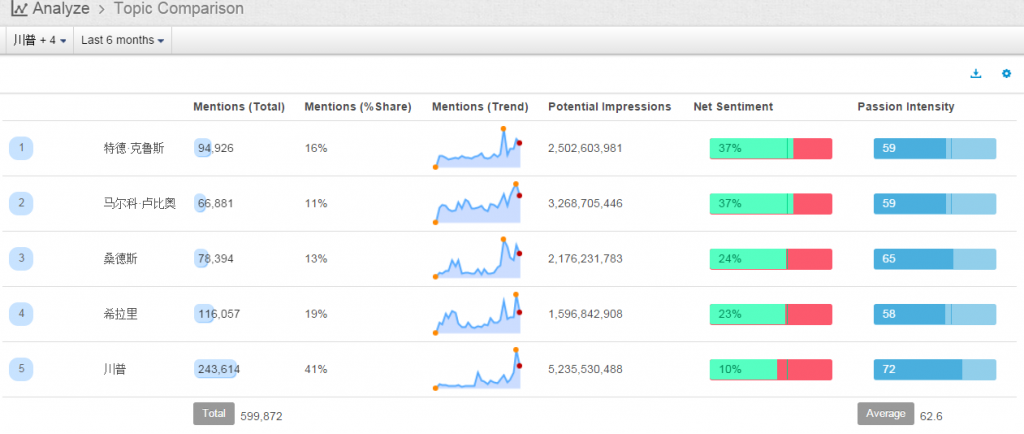








 I showed the First Lady's news pictures to my daughter. She was so intrigued, "Dad, Mom told me that you used to teach First Lady many years ago, is that true?" "It is true, but that was only a short time, one or two semesters, and it was not her major course. As a part-time lecturer, I was teaching Advanced English to graduate students in the music conservatory and she happened to be one in my class. She was already famous then as a new star for folk songs." Tanya got excited, "Well, you never know, maybe her English training in graduate school helps her in state visits today. My Dad is cool." She continued, "Dad, Mom also told me that you were interpreter for foreign minister when she dated you, is that true?" "Well, that was largely an accident, only happened once when I substituted some professor to act as interpreter for the former foreign minister and former Chinese congress vice-chairman Mr. Huang Hua. Your Mom agreed to date me partially because of her seeing a picture of me interporeting for the VIP Mr. Huang. So I guess I benefited from that 'accident'." Tanya was amused and felt very proud, "I have the coolest Dad in the world. He was so successful even when he was young, teaching future first lady and interpreting for the then foreign minister. Wow."
I showed the First Lady's news pictures to my daughter. She was so intrigued, "Dad, Mom told me that you used to teach First Lady many years ago, is that true?" "It is true, but that was only a short time, one or two semesters, and it was not her major course. As a part-time lecturer, I was teaching Advanced English to graduate students in the music conservatory and she happened to be one in my class. She was already famous then as a new star for folk songs." Tanya got excited, "Well, you never know, maybe her English training in graduate school helps her in state visits today. My Dad is cool." She continued, "Dad, Mom also told me that you were interpreter for foreign minister when she dated you, is that true?" "Well, that was largely an accident, only happened once when I substituted some professor to act as interpreter for the former foreign minister and former Chinese congress vice-chairman Mr. Huang Hua. Your Mom agreed to date me partially because of her seeing a picture of me interporeting for the VIP Mr. Huang. So I guess I benefited from that 'accident'." Tanya was amused and felt very proud, "I have the coolest Dad in the world. He was so successful even when he was young, teaching future first lady and interpreting for the then foreign minister. Wow."




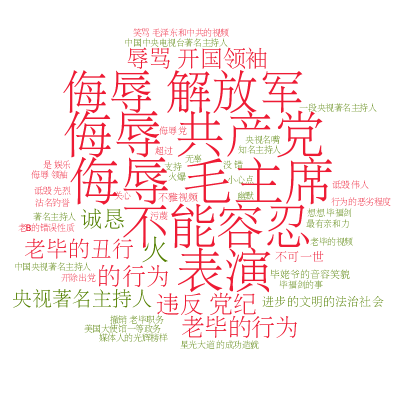



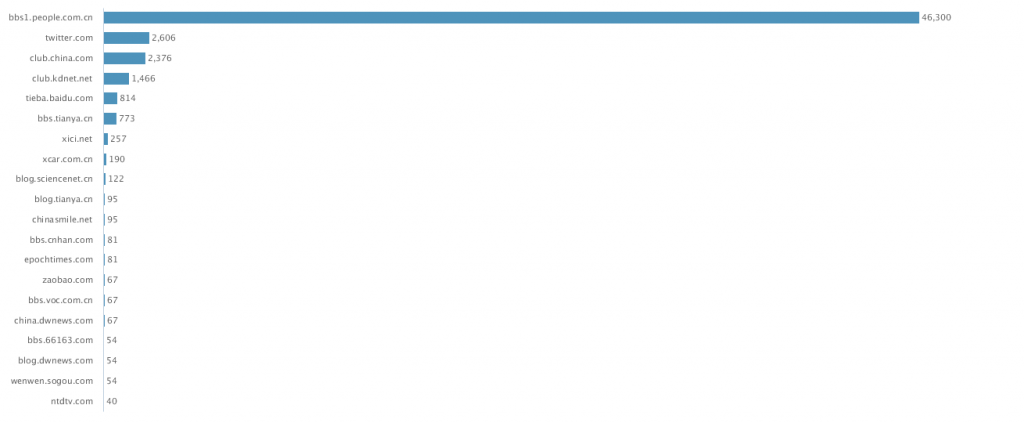





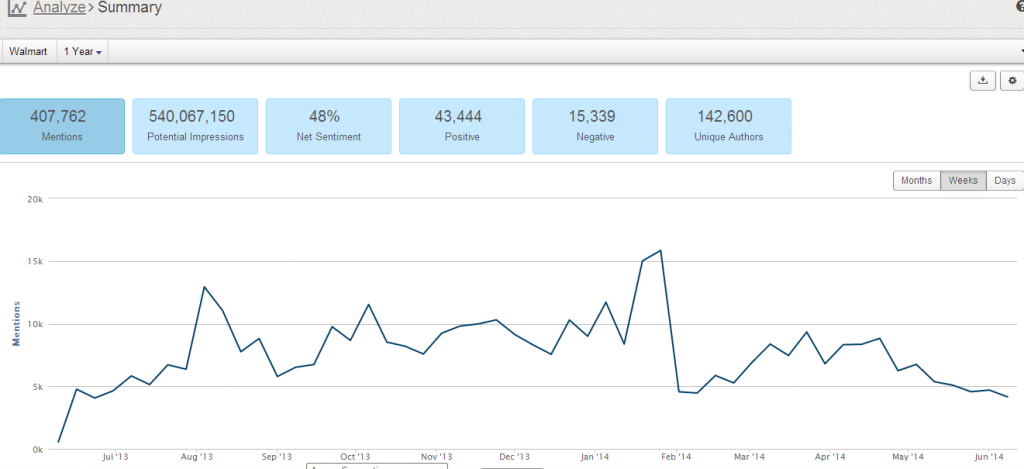
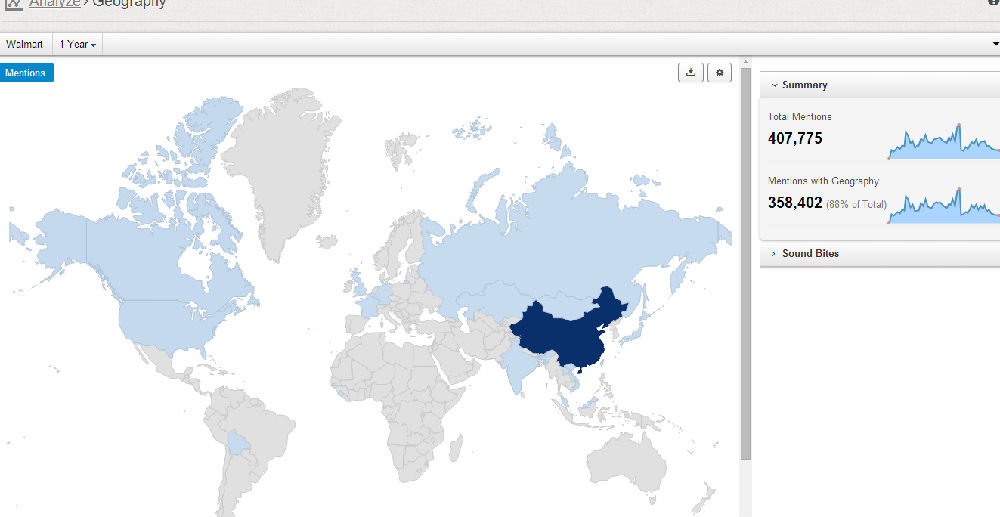


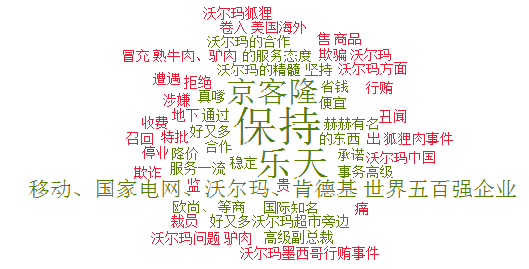
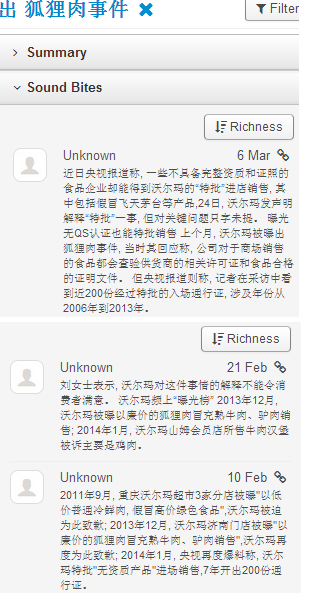







 您知道发一个好评多少钱吗?大公司有公关部的。
您知道发一个好评多少钱吗?大公司有公关部的。 
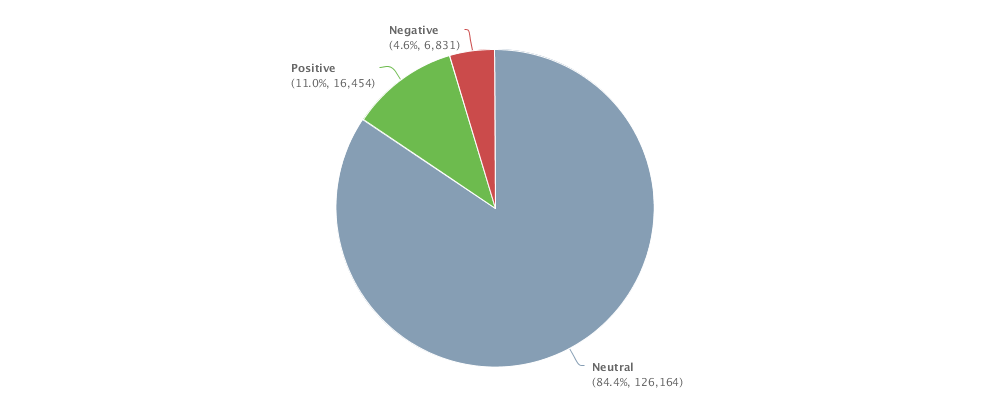






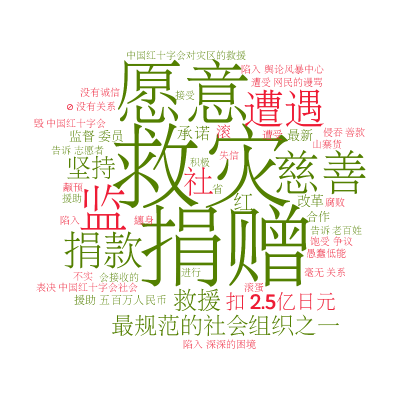







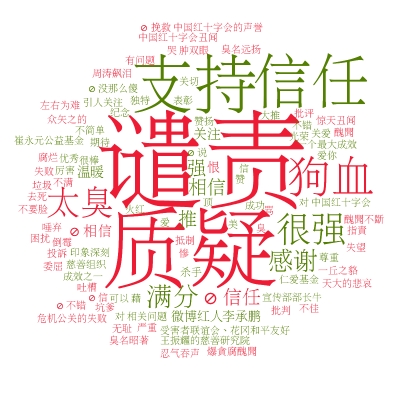


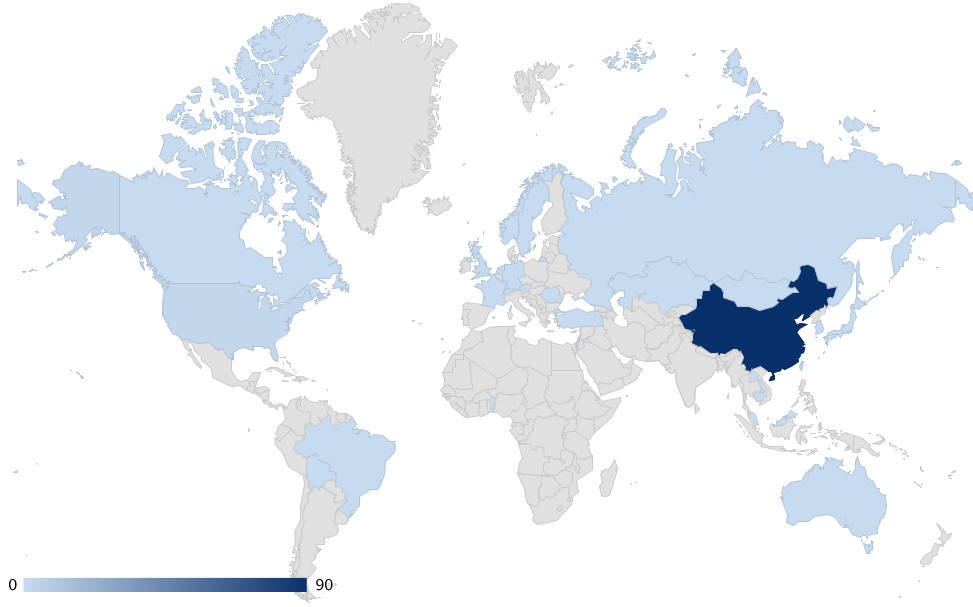
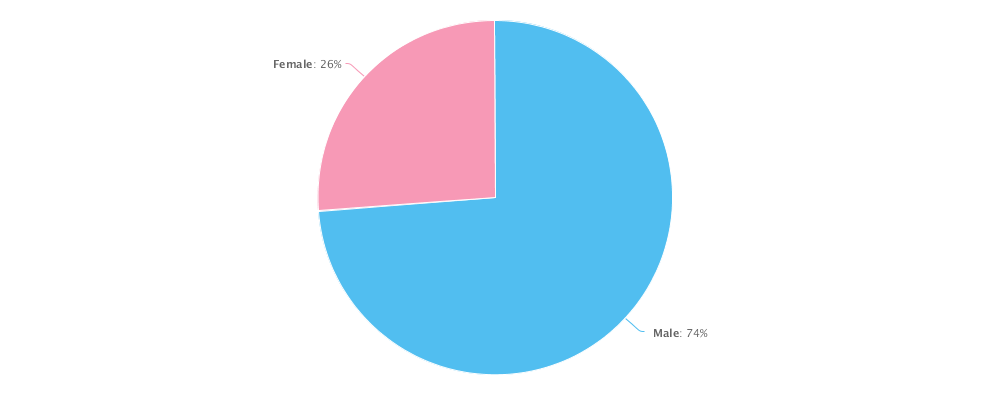
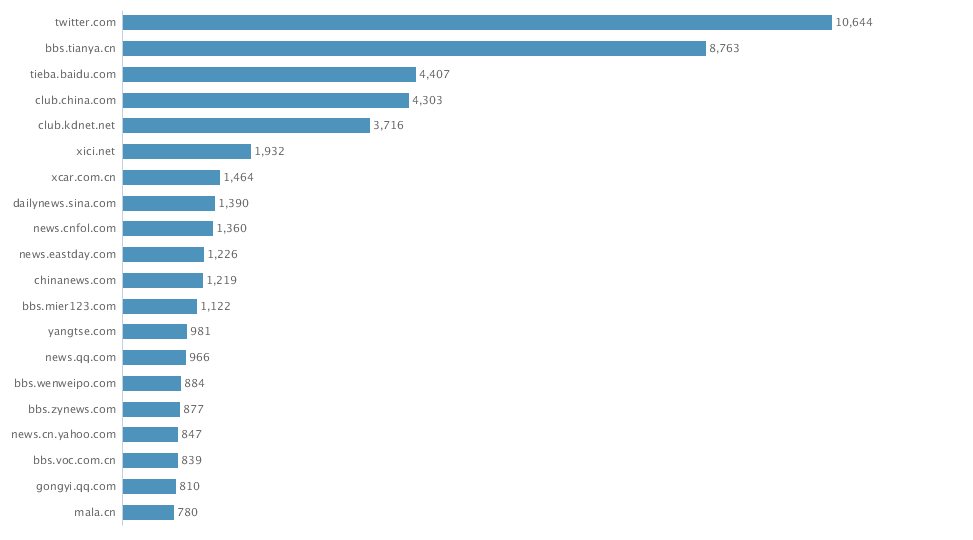



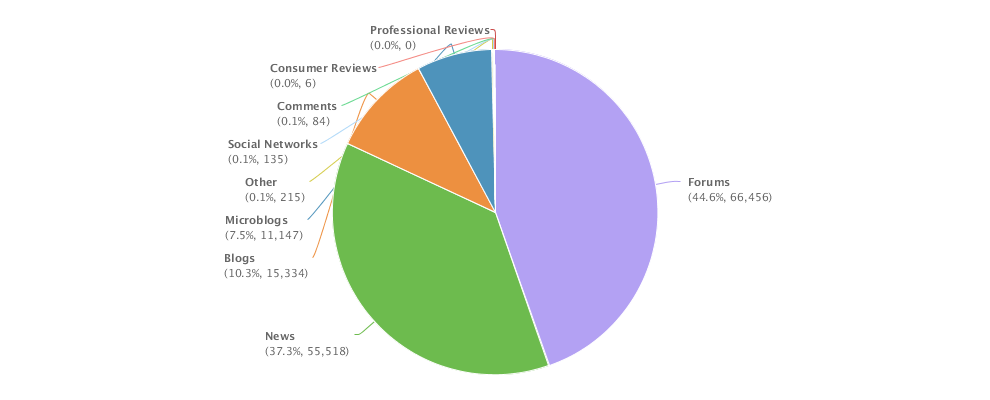
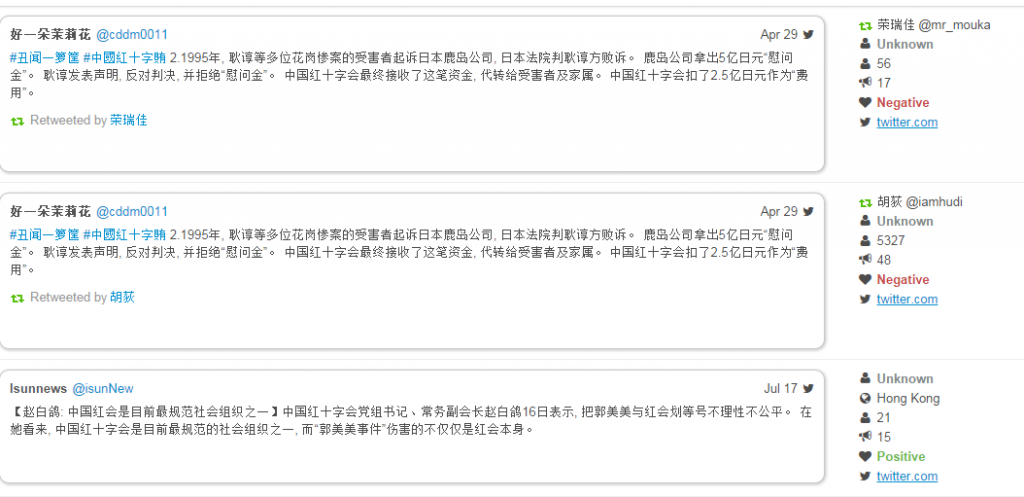
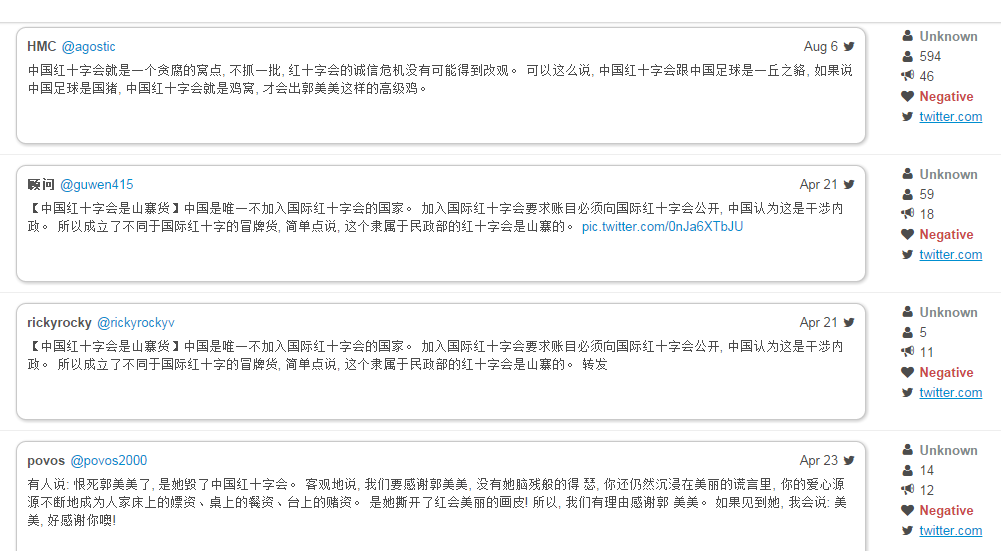





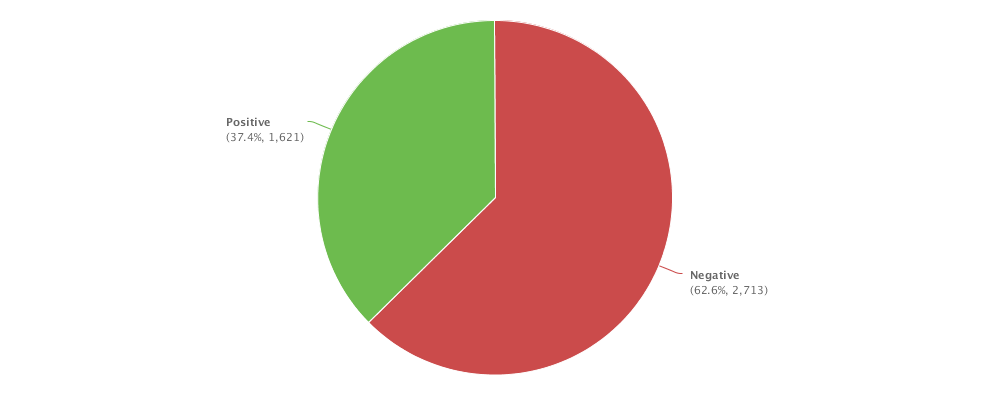



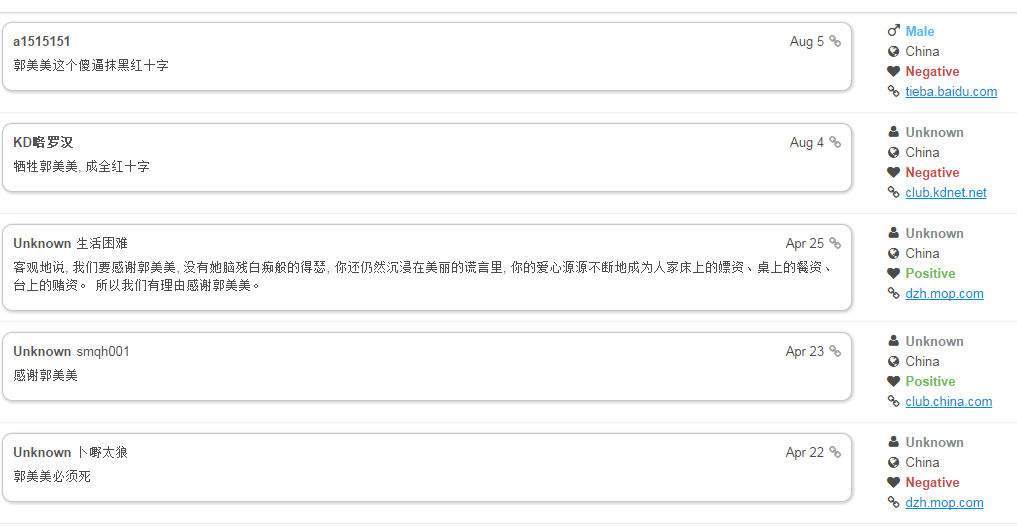



















































 两相对比,立委这个interview让我看到了你坐backoffice的巨大潜力
两相对比,立委这个interview让我看到了你坐backoffice的巨大潜力 - 立委
- 立委  台上一秒钟,台下几年功,一点不错!立委多年的奋斗终于开花结果了!
台上一秒钟,台下几年功,一点不错!立委多年的奋斗终于开花结果了!















